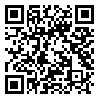Volume 15, Issue 1 (Apr & May 2021)
payavard 2021, 15(1): 74-83 |
Back to browse issues page
Ethics code: IR.TUMS.SPH.REC.1399.106
Download citation:
BibTeX | RIS | EndNote | Medlars | ProCite | Reference Manager | RefWorks
Send citation to:



BibTeX | RIS | EndNote | Medlars | ProCite | Reference Manager | RefWorks
Send citation to:
Mohammadzadeh N, sajjadi S H, Sajjadi S H. Modeling, Designing and Evaluating A Social Network in the Field of Health. payavard 2021; 15 (1) :74-83
URL: http://payavard.tums.ac.ir/article-1-7008-en.html
URL: http://payavard.tums.ac.ir/article-1-7008-en.html
1- Assistant Professor, Department of Health Information Management, School of Allied Medical Sciences, Tehran University of Medical Sciences, Tehran, Iran
2- Assistant Professor, Research Institute for Information and Communication Technology, Tehran, Iran
3- Master of Sciences Student in Health Information Technology, School of Allied Medical Sciences, Tehran University of Medical Sciences, Tehran, Iran ,Hasan.sajjadi1995@gmail.com
2- Assistant Professor, Research Institute for Information and Communication Technology, Tehran, Iran
3- Master of Sciences Student in Health Information Technology, School of Allied Medical Sciences, Tehran University of Medical Sciences, Tehran, Iran ,
Abstract: (1446 Views)
Background and Aim: Social networks that provide users with health data not only educate them but also play an active role in the health decision-making process. Health social networks, in addition to being a good tool for better patient communication with health care providers, can play an effective role in connecting similar patients with each other to receive social support. Social networking is one of the biggest achievements of Web 2, which facilitates communication between people. Despite the spread of social networks, their use in the field of health is still at its early levels. To implement an information system, it is first necessary to identify, design and model the related processes. The main purpose of this study was to provide technical documentation for the development of social networks in the field of health in order to facilitate future developments.
Materials and Methods: This study was an applied research. Due to the review of texts in the first phase, this research was descriptive. It is also a developmental research due to its technological dimensions in modeling and pattern model presentation. First, extracted features were confirmed based on experts’ opinions. Then, according to the identified features, social network modeling was performed at three levels of data, functional and process. Based on the modeling, a prototype model was designed and evaluated.
Results: In this research, technical documents were prepared for the development of social networks in the field of health in the three axes of data modeling, functional modeling and process modeling. In the usability assessment by Nielsen model, the created prototype based on modeling was evaluated. Finally, the number of problems in each case of the Nielsen model was determined. The case of "Visibility of system status" with 26.31 and "Consistency and standards" with 5.27 were associated with the highest and lowest problems, respectively.
Conclusion: The growing need and expansion of the use of social networks has created a good platform for using this tool in the field of health and exploiting its benefits. The present study focuses on providing technical documentation for the development of health social networks and to facilitate the development of social networks in the field of health.
Materials and Methods: This study was an applied research. Due to the review of texts in the first phase, this research was descriptive. It is also a developmental research due to its technological dimensions in modeling and pattern model presentation. First, extracted features were confirmed based on experts’ opinions. Then, according to the identified features, social network modeling was performed at three levels of data, functional and process. Based on the modeling, a prototype model was designed and evaluated.
Results: In this research, technical documents were prepared for the development of social networks in the field of health in the three axes of data modeling, functional modeling and process modeling. In the usability assessment by Nielsen model, the created prototype based on modeling was evaluated. Finally, the number of problems in each case of the Nielsen model was determined. The case of "Visibility of system status" with 26.31 and "Consistency and standards" with 5.27 were associated with the highest and lowest problems, respectively.
Conclusion: The growing need and expansion of the use of social networks has created a good platform for using this tool in the field of health and exploiting its benefits. The present study focuses on providing technical documentation for the development of health social networks and to facilitate the development of social networks in the field of health.
Send email to the article author
| Rights and permissions | |
 |
This work is licensed under a Creative Commons Attribution-NonCommercial 4.0 International License. |






